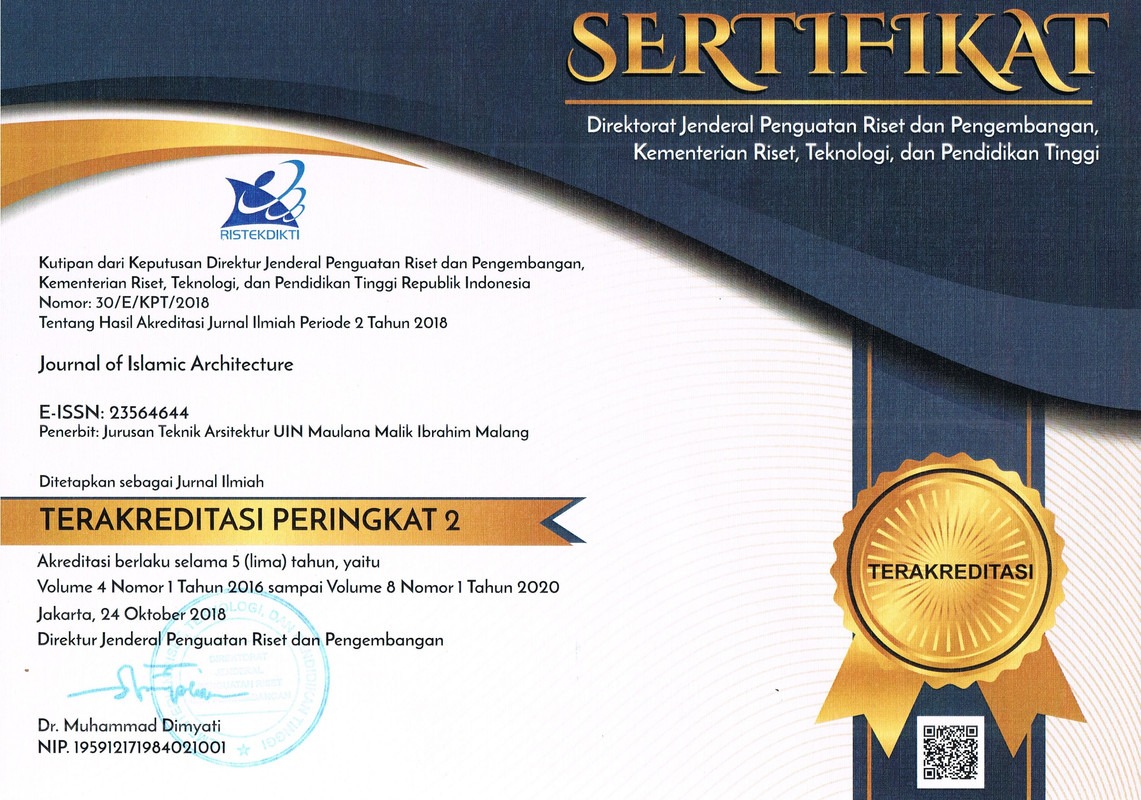Revisiting K.A.C. Creswell’s Theory on the First Mosque in Islam
Abstract
Keywords
Full Text:
PDFReferences
K. A. C. Cresswell, Early Muslim Architecture: with a Contribution on the Mosaics of the Dome of the Rock in Jerusalem and the Great Mosque in Damascus by Marguerite Gautier-van Berchem, [1940, 196. New York: Hacker Art Books, 1979.
Robert Hillenbrand, “Creswell and Contemporary Central European Scholarship,” Muqarnas, vol. 8, pp. 23–35, 1991.
J. Warren, “Creswell’s Use of the Theory of Dating by the Acuteness of the Pointed Arches in Early Muslim Architecture,” Muqarnas, vol. 8, pp. 59–65, 1991.
J. M. Rogers, “Architectural History as Literature: Creswell’s Reading and Methods,” Muqarnas, vol. 8, pp. 45–54, 1991.
T. Fitzherbert, “The Creswell Photographic Archive at the Ashmolean Museum, Oxford,” Muqarnas, vol. 8, pp. 125–127, 1991.
G. Karnouk, “The Creswell Library: A Legacy,” Muqarnas, vol. 8, pp. 117–124, 1991.
K. A. C. Cresswell, The Muslim Architecture of Egypt. Volume I: Ikhishīds and Fāṭimīds, A.D. 939-1171. London: Oxford University press, 1952.
K. A. C. Cresswell, The Muslim Architecture of Egypt. Volume II: Ayyūbids and Early Baḥrīte Mamlūks, A.D. 1171-1326. London: Oxford University press, 1959.
K. A. C. Creswell, Al-ʿImāra al-Islāmiyya fī Miṣr, al-mujallad al-awwal: al-Ikhshīdiyyūn wa-l al-Fāṭimiyyūn, trans. by ʿAbd al-Wahāb ʿAllūb. Cairo: Maktabat Zahrāʾ al-Sharq, 2004.
K.A.C. Creswell, A Bibliography of Architecture, Arts and Crafts of Islam to 1st January 1960. Cairo: American University in Cairo Press, 1961.
R. W. Hamilton, “Keppel Archibald Cameron Creswell 1879–1974,” Proc. Br. Acad., vol. LX, pp. 1–20, 1974.
Kristie Burns, “Cairo’s Creswell Collection: A Legacy of Love,” Am. Libr., vol. 22, no. 10, pp. 940-941-944, 1991.
C. L. Geddes, Ed., Studies in Islamic art and architecture: in honour of Professor K. A. C. Creswell. Cairo: The Center for Arabic Studies, 1965.
G. R. D. King, The Traditional Architecture of Saudi Arabia. London: I.B. Tauris, 1998.
G. R. D. King, “Creswell’s Appreciation of Arabian Architecture,” Muqarnas, vol. 8, pp. 94–102, 1991.
G. R. D. King, “Building Methods and Materials in Western Saudi Arabia,” Proc. Semin. Arab. Stud., vol. 14, pp. 71–78, 1989.
B. Finster, “Zu der Neuauflage von K. A. C. Creswells ‘Early Muslim Architecture,’” Kunst Orient., vol. 9, no. 1–2, pp. 89–98.
K. al-D. Sāmiḥ, Al-ʿImāra fī Ṣadr al-Islām. Cairo: al-Hayʾa al -ʿĀmma al-Miṣriyya lil Kitāb, 1982.
F. Shāfiʿī, Al-ʿImāra al-ʿArabiyya fī Miṣr al-Islāmiyya: ʿAṣr al-Wulāh. Cairo: al-Hayʾa al-Miṣriyya al-ʿĀmma lil Taʾlīf wal Nashr, 1970.
F. Shāfiʿī, Al-ʿImāra al-ʿArabiyya al-Islāmiyya: Māḍīhā wa Ḥāḍiruhā wa Mustaqbaluha. Riyadh: King Saud University Press, 1982.
A. Fikrī, Al-Masjid al-Jāmiʿ bil Qayrawā. Cairo: al-Ma’arif, 1936.
A. Fikri, Masājid al-Qāhira wa Madārisuhā: al-Madkhal. Cairo and Alexandria: Dār al-Maʿārif, 1963.
L. Caetani, Annali dell’Islam, 10 vols. Milan: Ulrico Hoepli.
G. Fehervári, “Art and Architecture,” in The Cambridge History of Islam, Paperback., Cambridge: Cambridge University Press, 1977, p. 703.
O. Grabar, The Formation of Islamic Art. New Haven, London: Yale University Press, 1973.
W. M. Watt, Muhammad at Medina. Oxford: Clarendon Press, 1956.
L. Golvin, “Essai sur l’Architecture Religieuse Musulmane,” Généralités, vol. 1, pp. 21–33, 1970.
J. Pedersen, “Masdjid,” The Encyclopaedia of Islam. 1991.
J. Johns, “The ‘House of the Prophet’ and the Concept of the Mosque,” in Bayt al-Maqdis: Jerusalem and Early Islam, J. Johns, Ed. Oxford: Oxford Studies in Islamic Art, 1999, pp. 59–112.
O. Grabar, “Art and Architecture and the Qurʾan,” in Early Islamic Art, 650-1100, Hampshire: Ashgate Publishing Limited, 2005.
K. A. C. Creswell, A Short Account of Early Muslim Architecture. Beirut: : Librairie du Liban, 1958.
Al-Bukhari, Book of Adhān, ḥadīths.
Creswell, “The Evolution of the Minaret with Special Reference to Egypt,” Burlington Magazine, pp. 127–83, Jan-1926.
J. M. Bloom, “Creswell and the Origins of the Minaret,” Muqarnas, vol. 8, pp. 55–58, 1991.
A. Dāwūd, ḥadīth.
Al-Bayhaqī, ḥadīth.
Al-Samhūdī, Wafāʾ al-Wafā bī Akhbār Dār al-Muṣṭafā, II. Beirut: Dār al-Kutub al-ʿIlmiyya, 1955.
I. Al-Najjār, Al-Durra al-Thamīna fī Tārīkh al-Madīna. Cairo: Maktabat al-Thaqāfa, 1981.
J. Sauvaget, La Mosquée Omeyyade de Médine: Études sur les Origines Architecturales de la Mosquée et de la Basilique. Paris: Vanoest, 1947.
I. Saʿd, Kitāb al-Ṭabaqāt al-Kabīr, 11 vols, Iii. Cairo: Maktabat al-Khanjī, 2001.
Al-Balādhurī, Futūḥ al-buldān. Beirut: Dār al-Nashr li-l Jāmiʿiyyīn, 1957.
Muslim, Musnad al-imām Aḥmad b. Ḥanbal, 50 vols, V. Beirut: Muʾssasat al-Risāla, 1996.
Al-Balādhurī, Ansāb al-Ashrā, Vol I. Cairo, 1959.
I. Hishām, Al-Sīra al-Nabawiyya, 4 vols, 3rd edn. Dār al-Kitāb al-ʿArabī, 1990.
U. Rubin, “Morning and Evening Prayers in Early Islam,” in The Development of Islamic Rituals, G. R. Hawting, Ed. Aldershot: Ashgate Publishing Limited, 2006.
Qur’an.
Al-Suhaylī, Al-Rawḍ al-Unuf fī Tafsīr “al-Sīra al-Nabawiyya l-ibn Hishām,” II. Beirut: Dār al-Kutub al-ʿIlmiyyah.
Al-Bukhari, hadith no. 476.
I. Ḥajar Al-ʿAsqalānī, Fatḥ al-Bārī bī Sharḥ al-Bukhārī, 14 vols. Cairo: Muṣṭafā al-Ḥalabī, 1959.
A. J. Wensinck, A Handbook of Early Muhammadan Tradition: Alphabetically Arranged. Leiden: Brill, 1960.
Al-Bukhari, hadith no 438.
Muslim, hadith no. 1161-1167.
Al-Darimi, hadith no 1429.
I. Hanbal, hadith no 11858.
Y. b. S. al-D. Al-Nawawī, Ṣaḥīḥ Muslim bi Sharḥ al-Nawawī, 18 vols, V. Cairo: al-Maṭbaʿa al-Miṣriyya, 1929.
I. S. Al-Nās, ʿUyūn al-Athar Fī Funūn al-Maghāzī wa-l Shamāʾl wa-l Siyar, I. Medina: Maktabat Dār al-Turāth.
Al-Marāghī, Taḥqīq al-Nuṣra bi Talkhīṣ Maʿālim Dār al-Hijra. Medina: al-Maktaba al-ʿIlmiyya, 1955.
Al-Ṭabarī, Tārīkh al-Rusul wal Mulūk, 2nd rev. Cairo: Dār al-Maʿārif, 1967.
H. Lammens, “Les Sanctuaires pré-Islamites dans l’Arabie occidentale,” Mélanges de I’Université de Saint-Joseph, vol. 11, pp. 119–120, 1926.
A. Guillaume, The Life of Muḥammad: A Translation of Ibn Isḥāq’s “Sīrat Rasūl-Allāh.” Lahore: Karachi, 1967.
I. Rusta, Al-Aʿlāq al-Nafīsa wa-Yalīhi Kitāb al-Buldān lil Yaʿqūbī. Leiden: Brill, 1891.
S. D. Goitein, “The Origin and Nature of the Muslim Friday Worship,” in Studies in Islamic History and Institutions, Leiden: Brill, 1966, pp. 111–125.
Muslim, hadith no 1978-1983.
Al-Nasāʾī, hadith no 1368.
Al-Nasāʾī, hadith no 1369.
I. Rifʿat, Mirʾāt al-Ḥaramayn: al-Riḥlā al-Ḥijāziyya wa-l Ḥajj wa-Mashāʿiruhū al-Dīniyya, 2 vols, I. Cairo: Maṭbaʿat Dār al-Kutub al- Miṣriyya, 1925.
Al-Ṭabarānī, al-Muʿjam al-Kabīr. Cairo: Maktabat Ibn Taymiyyah, 1983.
Al-Bukhari, hadith no 420.
S. b. Manṣūr, Sunan. Beirut: Dār al-Kutub al-ʿIlmiyya, 1967.
Al-Bukhari, hadith no 425.
DOI: https://doi.org/10.18860/jia.v4i4.4267
Refbacks
- There are currently no refbacks.






